As the skies turn orange it can be a terrifying situation. Strong gusty winds, along with intense heat and flames will make you tired quickly. Thick, heavy smoke will make it difficult to see and breathe. The roaring sound of the fire approaching will deafen you. Power and water may be cut off. You may be isolated. It will be dark, noisy and physically and mentally demanding. So whether you choose to leave early to go to a safer place or stay to defend your home, planning and preparation is the key to survival.
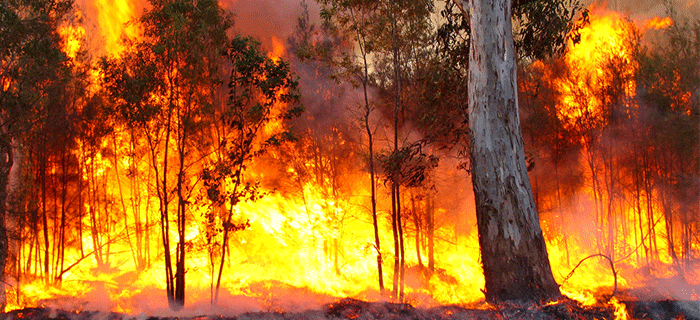
Be well informed – Bush Fire Apps
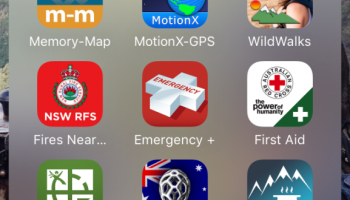
Bushfires can happen at any time but you must be extra alert during warmer weather, especially if you’re away on holidays. Fires can also jump gaps like rivers, roads, and firebreaks. Embers can travel many kilometres ahead of a fire, so even if you’re not directly threatened by a bushfire, you may be impacted by embers. Being well informed could save your life.
- Getting to know your wider environment and checking if you are in a bush fire prone area is essential.
- Get to know the alert levels, they will give you an idea of the danger.
- The bush fire prone land mapping tool (“Tool”) has been created by some states by the Rural Fire Service. It is designed to identify if your property is designated as bush fire prone.
- There is a FireReady App, which can be set up to give alerts, so you will know if a fire starts anywhere within 20km alerts.
- The ‘Fires Near Me ‘ App offered by NSW will allow you to keep track of the alert level, so you know what you should do.
- ‘MyFirePlan’ app is also available for you to write down your bush Fire survival Plan.
- Keep all Bushfire information numbers, websites and the smartphone app to hand.
- Follow the rural fire service on Twitter or Facebook for updates and share it with family or friends.
- Following emergency services on all social media for updates not only tells you the direction you need to take and even the road blocks.
- Listen to radio updates as they will also give you advanced warning so you have time to get out.
- As everyone may be on their mobile phone, the network may be slow so having a portable radio with spare batteries allows you to listen to instructions on local radio.
- Have a backup plan for the whole family and review it each year. The safety of your family is more important than your home.
Prepare your home
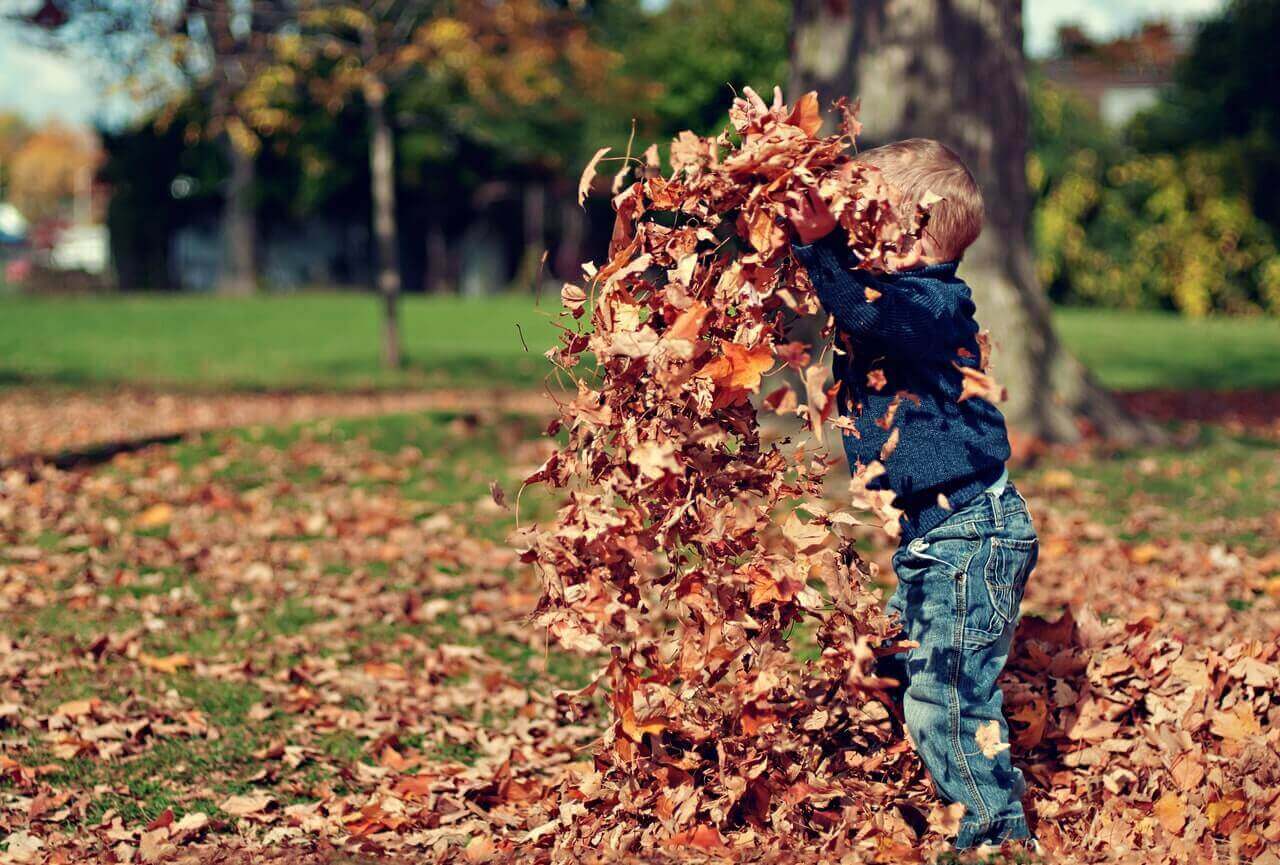
Planning and preparing your home for a bushfire can dramatically increase the chances of your family and your home surviving. So if you live in a bushfire prone area it is your responsibility to reduce the risk
- Install quality metal gutter leaf guards and clean leaves from gutters, roofs, chimneys and downpipes regularly.
- Install fine steel wire mesh metal (not plastic) screens on all windows, doors, vents and weep holes.
- Fit seals around doors and windows to eliminate gaps.
- Enclose the open areas under your house decks and floors.
- Seal all gaps in external wall cladding and broken roof tiles.
- Make sure when installing LPG cylinders around your home that pressure relief valves face outwards so that flame is not directed towards the house.
- Have hoses long enough to reach around your house and to the perimeter of your property.
- Ensure your fireplace chimney is clean.
- Remove and store flammable items (including wood piles) well away from your house.
- Have a non-combustible doormat.
- Keep mulch away from the house and grass short (under 5cm in length).
- Trim low lying branches two metres from the ground surrounding your home.
- On Total Fire Ban days obey regulations regarding barbecues and open fires.
- Ensure that if there is a fire hydrant outside your home it is easily located and not obstructed.
Defending your property as a bushfire approaches
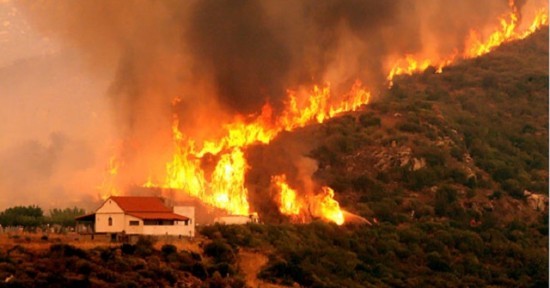
A bushfire can be a terrifying situation. Do you leave early or stay and defend it? Intense heat and thick, heavy smoke will make it difficult to see and breathe. The roaring sound of the fire approaching will deafen you. Power and water may be cut off. You may be isolated. It will be noisy, dark and physically and mentally demanding.
- Stay calm.
- Don’t enter the bush if smoke or fire is in the area. Report all fires, ring 000.
- Check if elderly neighbours need assistance.
- Patrol the outside of your home, putting out any embers and spot fires that may start.
- Close all windows, doors and shutters.
- If possible, block your downpipes (a sock full of sand/soil will help) and fill roof gutters with water.
- If possible, block gaps beneath doors with wet blankets or towels.
- Collect water in buckets/bath, as you can also soak towels in it to protect your body if you have to evacuate when the fire is near.
- Consider keeping valuables items and documents in a fire resistant safe or metal cabinet, or have them packed and ready to go.
- Comply with police if ordered to evacuate.
- Bring your garden hose inside so that it won’t melt in the fire and can still be used.
- Wet down timber decks and gardens close to the house if the fire is approaching.
- Do not stand on your roof with your hose. In bushfires, often more people are injured by falling from roofs than suffering burns.
- Keep ladders, shovels and metal buckets at hand to help put out spot fires.
- Keep a torch and a portable battery operated radio in the home in case electricity supply fails.
- Drink plenty of water so you do not dehydrate.
- Move any firefighting equipment to a place that it will not get burnt.
Make sure you have an evacuation plan for your pets too. Pets will panic but trapping them in a separate room with their lead or pet carrier at the ready means in the heat of the moment you can get them into the back of the car more easily.
Have a survival kit
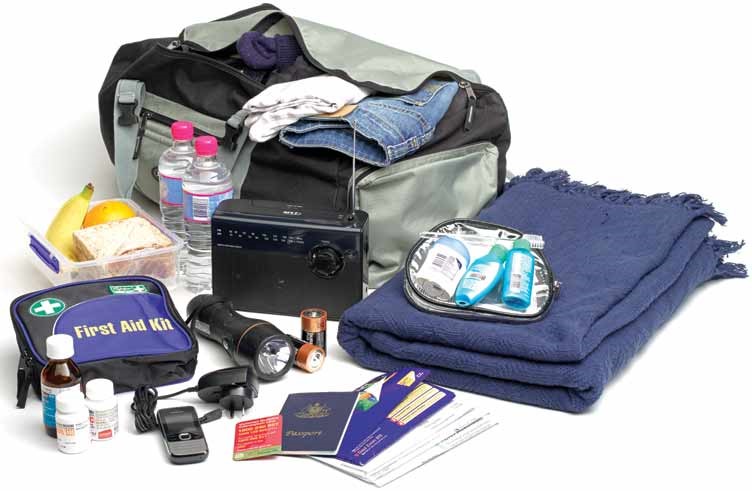
As the fire approaches panic to escape makes you forget everything. When the fire is outside your door your adrenaline is high, so you will not be able to think effectively, so plan ahead and prepare an emergency survival kit before the bush fire season starts. Having a prepared kit means having easy access to things that can help you survive a bush fire or other natural disaster. It will be in one handy location. This kit will help you regardless of whether you are going to leave, or stay and actively defend your home.
- Portable battery-operated radio.
- Several Waterproof torches for each member of the family (even if it is in the middle of the day it can get pitch black).
- Head torches.
- Spare batteries.
- First aid kit with manual.
- Candles with waterproof matches.
- Woollen blankets.
- Emergency contact numbers.
- Waterproof bag for valuables.
- Wallet with cash, ATM cards, credit cards.
- Medications needed, toiletries and sanitary supplies.
- Special requirements for infants, elderly, injured, disabled.
- Mobile phone and charger.
- Combination pocket knife.
- Important insurance documents and photos on a USB stick (in a waterproof bag).
- Change of clothes for everyone.
- Drinking water (at least three litres per person per day).
- Food (non-perishable).
Keep your Emergency Survival Kit in a waterproof storage container in a location that is easy to get to and that the whole family knows about. This will make it quick and easy to find when you need it.
Remember to prepare for your pets as well. Make sure your pet is wearing an identification tag. If you’re leaving, take a leash, basket, medication, food and a familiar toy for your animal. It will help reduce stress.
Know where your community safer places are
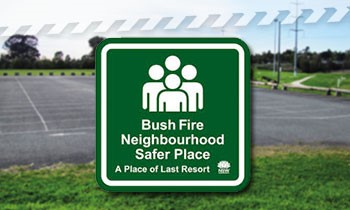
A ‘Neighbourhood Safer Place’ also known as a ‘Bushfire Place of Last Resort’ (NSP-BPLR) is a place of last resort when all other bushfire plans have failed. They are locations that may provide some protection from direct flame and heat from a fire. They are a clearing that provides separation distance from bushfire hazards but they are not an appropriate destination when the option is to leave the area early as they do not guarantee your safety.
- Your safest option will always be to leave early.
- The elderly and people with a disability, should always leave before the threat of bush fire.
- If it is unsafe to leave the area or stay and defend your property, and the path is clear, you should move to your pre-identified Neighbourhood Safer Place, prior to the impact of a bush fire.
- When you are travelling to your Neighbourhood Safer Place be aware that there may be heavy smoke and poor visibility.
- Gather at the Neighbourhood Safer Place location and remain there until the bush fire threat has passed.
- The conditions at the Neighbourhood Safer Place may be uncomfortable and you may be affected by heat, smoke and embers.
- Water, toilets and food may not be available at the Neighbourhood Safer Place and emergency service personnel may not be present, so take your survival kit with you.
- Neighbourhood Safer Places are not intended for pets and livestock.
Bushfire Danger Ratings
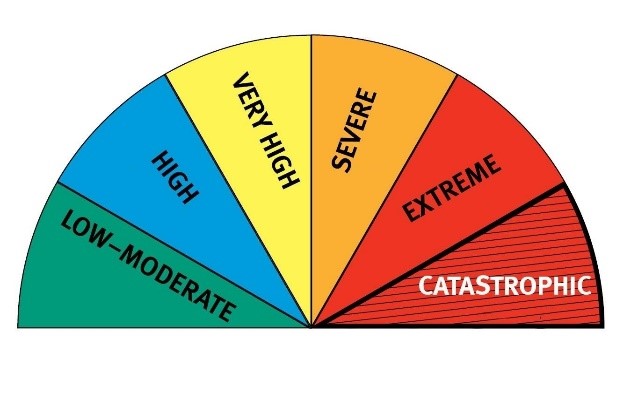
Fire danger ratings (FDR) help you to know when conditions are dangerous enough to put your bushfire survival plan in to action. Ratings are forecast using the Bureau of Meteorology data for up to four days in advance, based on weather on predicted conditions such as temperature, humidity, wind and the dryness of the landscape. The ratings is your prompt to take action and stay safe. Understanding the FDR categories and what they mean to you will help you make decisions about what to do when a bushfire starts as at each rating the fire behaviour and potential impact will be different. The potential impact on you will be different so in your bushfire survival plan you must know what actions you will take at each rating.
Low-Moderate, High and Very High. If a fire starts in these conditions it can most likely be controlled. Review your bush fire survival plan with your family. Keep yourself informed and monitor conditions. Be ready to act if necessary.
- If a fire starts and takes hold it may be uncontrollable. If you are unprepared leaving early in the day is your safest option. Well prepared homes that are actively defended can provide safety but only stay if you are physically and mentally prepared to defend in these conditions.
- Extreme If a fire starts it will be uncontrollable, unpredictable and fast moving, leaving early on an extreme day is your safest option. Only consider staying if you are prepared to the highest level, such as your home is specially designed, constructed or modified, and situated to withstand a fire, you are well prepared and can actively defend it if a fire starts.
- Catastrophic These are the worst conditions for fire, most homes are not designed to withstand fire in these conditions, leaving the night before is your safest option.
Alert Levels
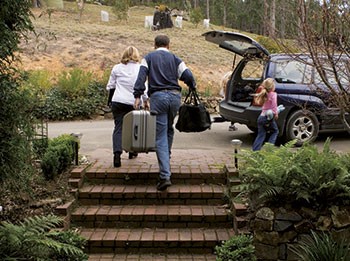
A bushfire alert is issued to the community by the Emergency Service Agency, once a bushfire has started taken hold. It is important to remember that bushfires can spread very quickly which means there is no time for any warnings to be issued, so don’t rely on a warning before you start acting to protect your family. So you may not always receive all 3 levels of Alerts in a consecutive order, you may simply receive an Emergency Warning first. There may also be situations where there is no time for any warnings to be issued at all.
Bushfire Alerts are issued using on Government websites, Twitter, Facebook, local radio and television.

.ADVICE – A fire has started but there is no immediate threat to lives or homes. Be aware and keep up to date.
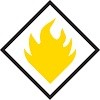
WATCH and ACT – There is a heightened level of threat. Conditions are changing and you need to start taking action now to protect yourself and your family. You need to leave or get ready to defend your home. Do not wait and see.

EMERGENCY WARNING – This is the highest level of Bushfire alerts. You may hear a siren to get your attention before the message about what you should do. You are in danger and need to take immediate action to survive. There is a threat to lives or home.
What to wear in a Bushfire
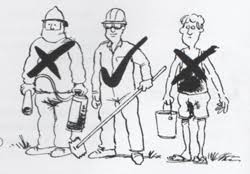
You’ve decided to stay and try to protect your home during a bushfire but have you thought about how you need to protect yourself?
It can get very hot during a bushfire and there may be sparks or embers flying around as well as fallen debris on the ground. For this reason you must make sure you’re wearing the right clothing to help protect you.
- Wear loose fitting long-sleeved clothing made from thick cotton or wool to protect your skin and from being burnt by radiant heat or embers.
- Heavy cotton long pants or denim jeans will protect your legs from heat and burning embers. Do not wear oil-stained clothes and avoid clothing made from synthetic fabric like nylon or polyester. Synthetic board shorts or swimmers, can melt and stick to your body.
- Wear a wide-brimmed hat or helmet to stop embers from dropping on to your head or down the back of your shirt.
- Wear goggles or wrap-around sunglasses to protect your eyes from debris, smoke and embers in the air.
- Protect your hands from heat and embers by wearing heavy work gloves, when picking debris up around your property.
- A filtered mask or cotton cloth/tea towel around your nose and mouth will help protect you from inhaling ash and smoke.
- Wear sturdy footwear such as heavy work-boots and woollen or cotton socks – it will help protect your feet and skin from heat and debris underfoot.
What to do on Total Fire Ban
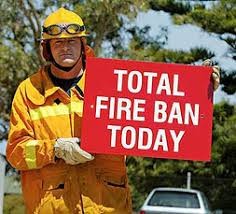
Bush fires are more likely to spread and cause damage on days when the weather is very hot, dry and windy. These are usually on very high to extreme fire days. To reduce the risk of fires damaging or destroying life, property and the environment a Total Fire Ban may be declared. A Total Fire Ban helps limit the potential of fires developing
- You cannot light, maintain or use a fire in the open, or to carry out any activity in the open that causes, or is likely to cause, a fire.
- No general purpose hot works, such as welding or gas cutting can be done in the open.
- It is recommended you reconsider activities such as such using a tractor or slashing, to help reduce the chance of a fire starting on your property.
- A Cease Harvest request may be issued.
- You can use an electric barbeque for cooking as long as it is under the direct control of a responsible adult, who is present at all times while it is operating. No combustible material is allowed within two metres at any time it is operating.
- The barbeque is must be either in a designated picnic area and the appliance is approved by Council, National Parks or State Forest or within 20 metres of a permanent private dwelling with immediate and continuous supply of water.
- You cannot use a barbeque or wood fire pizza oven which uses solid fuel, such as wood, charcoal or heat beads, cannot be used outside during a Total Fire Ban.
- Fire Permits are suspended on days of Total Fire Ban. Permits may resume after the total fire ban is lifted, as long as the permit hasn’t expired.
- The burning of fires in the open or in incinerators is banned if it is of the opinion that, because forecast weather conditions, burning is likely to contribute to the build-up of air pollution. A No-Burn notice will be published in the newspaper on the day it is in force or information can be got from government websites.
- A range of activities may be exempt from Total Fire Bans, such as emergency infrastructure work, bee hive smokers, mining operations, sugar cane harvesting and use of fireworks or ceremonial fires. The exemptions are detailed in the local newspaperseach time a Total Fire Ban is declared.
- If you want to light a fire, or carry out any hot works activities during a Total Fire Ban you can check the Government Gazette to see if there is a standard exemption that applies to your situation. If the standard exemptions do not cover your circumstances then you may apply for a specific. If approved the Rural Fire Service will issue an Exemption that contains any conditions that you must follow when lighting the fire or conducting your activity on the total fire ban day.
- Lighting a fire on a day of Total Fire Ban attracts an on the spot fines. Penalties for a fire that escapes and damages or destroys life, property or the environment can attract much greater fines Civil law suits can also be brought against the person responsible for a fire by those seeking compensation for losses sustained.
Keep Your Insurance Up to Date
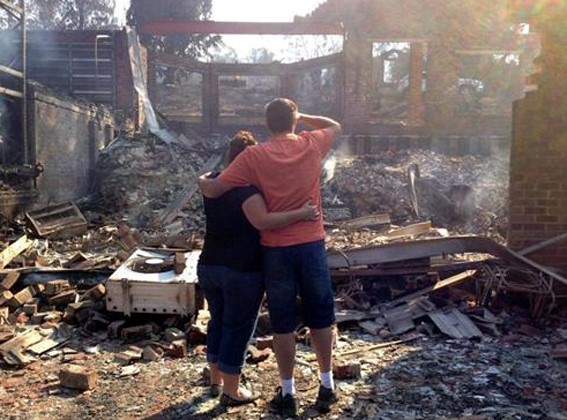
If you live in a bushfire-prone area it is important to be covered for the worst. Fire cover is a standard inclusion for most home and contents insurance policy’s but it is worth checking that the policy definitely includes bushfires as well as house fires. If you live in a bushfire-prone area it is important to be covered for the worst. Having sufficient insurance can make the difference between successfully rebuilding and suffering irreversible loss.
- Keep a copy of your insurance policy in a safe and accessible place as well as on a USB stick in your survival bag.
- Know how much the rebuild costs of your property will be.
- Check if you live in a bushfire prone area and relevant re-building requirements with your local government body or local fire authority.
- The cost of rebuilding is always going up so make sure that when you decide on the final amount to cover your home, it includes all these costs.
